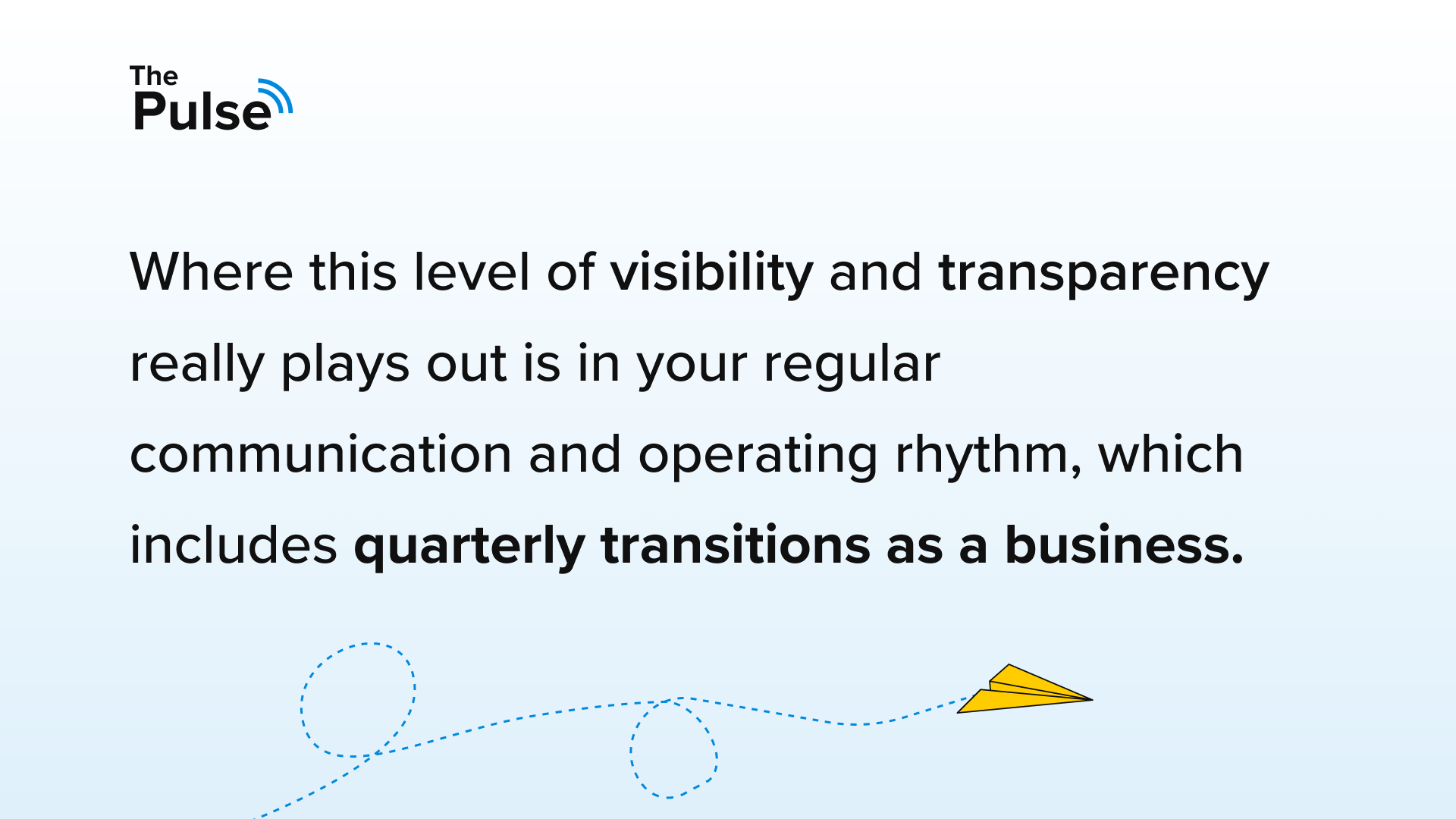
Welcome to the 25th edition of The Pulse, your bi-weekly newsletter of Insights for Strategy Leaders. And welcome to all of the new subscribers since last edition!
In this edition:
- 🎯 Quarterly Transitions: Building Momentum Heading Into H2
- ✈️ Holiday Extras Spotlight + Video
- 🎥 Last Week's Webinar Recording
- 🥜 Strategy Snack #1
Let's jump in.
Quarterly Transitions: Building Momentum Heading Into H2
Two weeks ago, we held our Company Kickoff for the start of Q2. As one of those software companies that has a fiscal year starting February 1st, we are off-cycle from most companies and the start of the calendar/fiscal year by a month.
As we wrapped up our Kickoff, one of our team members came up to us at the end of the day asked whether we communicate our process to customers and prospects.
We are big believers in practicing what we preach, so while the answer was ‘yes’, we thought it could be worth sharing with more than just those companies that work with Elate. And while I will preface that our exact process might not be right for everyone, there are core fundamentals we aim to accomplish with our process that should be universal.
At Elate, we emphasize visibility and transparency. We believe that providing context and direction for employees helps accomplish a few things, including:
- Empowering employees to work more autonomously through clarity by discerning how they can align their priorities with the company’s priorities.
- Reducing whiplash when we pivot, because folks understand the ‘why’ behind certain decisions we make. When they know the company’s vision, they understand that the means to achieve that vision may change.
- Enabling more successful cross-departmental work by highlighting what each team is working on and the dependencies across teams to bring goals to reality.
While there are many other reasons to create a strategic plan that is visible and transparent, these are some of the main benefits.
However, where this level of visibility and transparency really plays out is in our regular communication and operating rhythm, which includes quarterly transitions as a business.
Like most companies, we go through an annual planning process that kicks off in Q3 and runs through the end of Q4. During this process, we revisit our five-year strategy, define our operating plan for the year, and set annual Themes that help us stay aligned to the operating plan and our 5-year vision. We use these areas to then set our Q1 Objectives at a Leadership level, with clear, measurable outcomes that align with our operating plan, as well as our key business metric (Annual Recurring Revenue).
For most companies, Annual Planning is a familiar process, which we have written about in the past.
However, many of the companies we work with at Elate struggle with keeping this plan from becoming static.
For organizations that run the annual planning themselves, it often becomes challenging to get Leaders to stick to the strategy, or, if it changes, to ensure they are communicating what is changing and how it impacts other members of the organization.
For organizations partnering with outside consultants, it’s often even easier to allow the strategy to become dormant as a 50 page document that never leaves its perforated binder. 📒
In either case, organizations that struggle to bring their strategic plan to life in a living, breathing format that drives dynamic decision-making will inevitably lose the momentum and alignment they sought at the beginning of the year when the plan was communicated to employees.
To ensure that doesn’t happen, here are some suggestions that hopefully you can tie into the start of your next quarter as we head into the second half of 2024. These are the timelines we adhere to as a company at Elate:
3-4 Weeks Before Quarter-End: Validate Existing Objectives or Set New Objectives.
As we close in on the end of the quarter, Leaders shouldn’t be so fixated on the present that they ignore the upcoming quarter. For high-growth or quarterly sales-driven companies, this likely means setting new Objectives for the upcoming quarter. For organizations that operate on an annual basis, this is a great opportunity to validate and confirm that the Objectives set at the beginning of the year should remain in place. The idea is whether we should pivot or persist.
One Week before Quarter-End: Finalize Objectives.
Don’t let the Objectives you started working on languish in a state of purgatory. Work with other Leadership members to confirm and finalize Objectives with one week left in the quarter. We find that one of the best ways to finalize Objectives is by providing space for other Leaders to share expectations from other departments and map dependencies. We call these spotlight sessions, and they’re a great way to ensure Leaders are aligned on their Objectives and what will be needed from their teams.
End of the Quarter to One Week After: Communicate Department Objectives to Teams.
The company kickoff each quarter can serve as a great rallying cry. However, it’s essential that department Leaders communicate with their teams about their focus for the quarter and get their input on how to achieve the Objective. Get people invested in what they will be working on and why it matters to the overall business. This step might vary based on the size of your business or team location, but it’s important not to skip it. Evaluate if there are critical resources/teams needed to achieve an Objective for that quarter and prioritize communication accordingly.
One Week Before to Two Weeks After Quarter-End: Close Out Previous Quarter Objectives.
Reflecting and measuring past performance is crucial for improving our strategy. While we use Elate to score Objectives, we also meet as a Leadership team for a 90-minute session (often over breakfast/dinner) to reflect on what went well and what could have gone better last quarter. This is also a great way to get everyone excited about the upcoming quarter and ensure we are aligned.
One to Three Weeks After Quarter-End: Company Kickoff/Town Hall.
This is non-negotiable for us. A quarterly company kickoff recaps the past quarter’s wins and broadly communicates the focus for the next quarter. At Elate, we also use this as an opportunity to provide visibility to other Leaders across the business. As CEO, I often share our performance and revenue goals, but we also highlight each department and give their Leaders a voice. This helps ensure that directives are seen as thoughtful and collaborative, with all Leaders working to align Objectives across departments.
So there you have it. While there are a number of different steps and additional details that go into making each of these parts of the process successful, we anchor around these five areas as non-negotiables:
- Validate or Create New Objectives Each Quarter
- Formally finalize those Objectives for the Coming Quarter
- Close Out Previous Quarter or Completed Objectives
- Work with Departments/Teams to Finalize Objectives and Begin Communication
- Hold a Company Kickoff to Drive Alignment Across the Organization
If you’re ever interested in learning more about how we transition quarters at Elate, or even how our platform and team can help in the process, I’d love to connect. It’s always great to hear how other organizations are running this process today.
✈️ How Holiday Extras Takes a Cultural Approach to Strategic Alignment
For those interested in learning how we partner with organizations to help bring their strategies to life, check out our most recent customer story with Holiday Extras, UK's leading travel services company.
We also have a video (above) with Emma Bates, Head of Operational Business Excellence at Holiday Extras.
She talks through the pain they were feeling managing their strategy in Google Docs, why they chose Elate, and what they're looking forward to.
Thank you Emma and Holiday Extras for letting us share your story! 💜
🎥 Simplifying Strategic Planning for Success (a recording)
Last Thursday I went live with our friends at Velocity Advisory Group to talk strategic planning and wow the response was great.
We had nearly 100 Strategy and Operations Leaders join us live, which validates how complex strategic planning truly is and the pain leaders are feeling today.
We covered strategic planning trends over the last 10 years and how those have influenced strategic planning today, best practices on frameworks, and tied it all together with our top 3 suggestions on how to simplify strategic planning for success.
Above is the recording on Youtube (ungated) in case you want to watch it or save it for later!
What are some of the common mistakes organizations make when it comes to strategic planning?
Alright, that's all for today... Have a great rest of your week.
- Brooks


